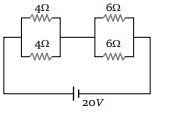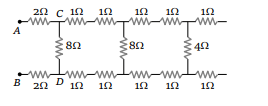1. Lamps used for household lighting are connected
in
a) Series
b) Parallel
c) Mixed circuit
d) None of the above
Explanation: Because all the lamps have same voltage
2.The equivalent resistance of resistors connected
in series is always
a) Equal to the mean of component resistors
b) Less than the lowest of component resistors
c) In between the lowest and the highest of
component resistors
d) Equal to sum of component resistors
Explanation:

3.Four wires of equal length and of resistances 10
ohms each are connected in the form of a square. The equivalent resistance between two opposite
corners of the square is
a) 10 ohm
b) 40 ohm
c) 20 ohm
d) 10/4 ohm
Explanation:


4. Two resistors are connected (a) in series (b) in
parallel. The equivalent resistance in the two
cases are 9 ohm and 2 ohm respectively. Then the
resistances of the component resistors are
a) 2 ohm and 7 ohm
b) 3 ohm and 6 ohm
c) 3 ohm and 9 ohm
d) 5 ohm and 4 ohm
Explanation:

5. Resistors of 1, 2, 3 ohm are connected in the form
of a triangle. If a 1.5 volt cell of negligible internal
resistance is connected across 3 ohm resistor, the
current flowing through this resistance will be
a) 0.25 amp
b) 0.5 amp
c) 1.0 amp
d) 1.5 amp
Explanation:

6.In the network of resistors shown in the adjoining
figure, the equivalent resistance between A and B
is

a) 54 ohm
b) 18 ohm
c) 36 ohm
d) 9 ohm
Explanation:

7. A wire is broken in four equal parts. A packet is
formed by keeping the four wires together. The
resistance of the packet in comparison to the
resistance of the wire will be
a) Equal
b) One fourth
c) One eight
d) \[\frac{1}{16}th\]
Explanation:

8. Four resistances are connected in a circuit in the
given figure. The electric current flowing through
4 ohm and 6 ohm resistance is respectively

a) 2 amp and 4 amp
b) 1 amp and 2 amp
c) 1 amp and 1 amp
d) 2 amp and 2 amp
Explanation:

Hence the current flowing through each resistance = 2 ampere.
9. An infinite sequence of resistance is shown in the
figure. The resultant resistance between A and B
will be, when \[R_{1}\] =1 ohm and \[R_{2}\] = 2 ohm

a) Infinity
b) 1 Ω
c) 2 Ω
d) 1.5 Ω
Explanation:

10. In the figure shown, the total resistance between
A and B is

a) 12 Ω
b) 4 Ω
c) 6 Ω
d) 8 Ω
Explanation:
